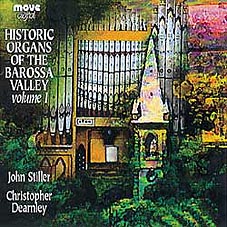Holy Cross Lutheran Church,
Gruenberg / Moculta
B 1871 D.H. Lemke.
1 manual, 4 speaking stops, no pedals, tracker.
Man: 8.8.4.2.
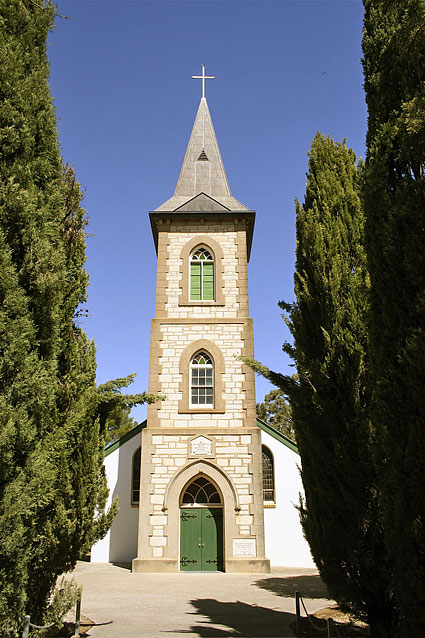
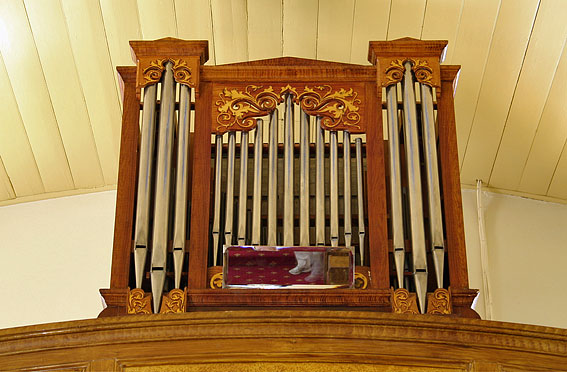
Recordings
John Stiller plays:
Friedrich Kümstedt - Herzlich tut mich verlangen
Johann Christoph Bach - Herr Jesu Christ, dich zu uns wend
Daniel Heinrich Lemke is the best known Barossa Valley organbuilder. He was born in 1832 and migrated from Germany to SA in 1853. He worked as a teacher and built organs in his spare time. Four are known to exist today - all in the same style with four octaves of keys on one manual with no pedals and foot treadles to pump the wind. The specifications were the same and none of his stop knobs had stop names on them, only pitches. He made his own wooden pipes but imported the metal ones.
The organ in Holy Cross Lutheran Church, Gruenberg was built by Lemke in 1871 (according to an inscription on a wooden pipe) and is the earliest of his existing organs. According to a newspaper report, it was his third organ. The organ was formerly blown by foot treadles but an electric blower was added in 1966.
Specification from the 1986 OHTA Conference booklet.
| Manual [Stopped] [Stopped] [Principal] [Fifteenth] |
8 8 4 2 |
wood wood metal metal |
Gedackt Quintadena |
Tenor A Tenor A |
compass 49 notes
location in west gallery
Stop knobs have no names, only pitches. From
the 2009 OHTA Conference Book,
David Shield writes: Three
families from Silesia settled the land around Gruenberg in 1853. The following year, a school was
organised and Pastor Kavel came from Tanunda for services in the settlers’
homes. Land was acquired in March
of 1859 and the first church/schoolroom constructed. Daniel Lemke became the teacher in the school in 1860. In 1864 it was resolved to build a new
church and the body of the current structure was dedicated on 16 October. After teaching at Eden Valley, Lemke
returned to Gruenberg in 1867. The
organ was placed in the church in 1871. The story of Daniel Lemke can start with Gruenberg. The Lemke family had, in fact, arrived
in 1855. They settled to farming
on land in the Barossa Goldfields before the rest of the family moved on to the
western districts of Victoria. A
single man, Daniel stayed on, eventually managing to sell the land before being
called to teach at Gruenberg in 1860.
He married Caroline Sagenschnitter, a farmer’s daughter of Parrots Hill
(Gnadenberg) in April the following year, his first child being born in
February 1862. He was called to
Eden Valley as the first teacher for its school in September 1862 where he
stayed until 1866. He returned to
Gruenberg in 1867 to teach before turning once again to farming in 1880. The teacher of a Lutheran day school was also expected to serve
the church as musician. Many
served for long periods.1
Initially at Gruenberg there had been no keyboard to accompany
congregational singing, a harmonium only being acquired in 1862.2 It comes as no surprise that if Lemke
had the skill, when returning to Gruenberg to teach in 1868, he might turn his
hand to construct an organ for the church. This he did, completing and installing the current
instrument in 1871.3 Four instruments built by Lemke are extant, all of similar
construction. Lutz implies Robert
Mackenzie may have worked on this instrument, though what was done is unknown.4 Apart from the electric blower added in
1966,5 this organ appears to be entirely original in form. From Stiller’s documentation, like the
organs at Ebenezer, Point Pass and Frankston in Victoria, the metal ranks are
not Lemke’s construction. The
keyboard has a short compass of 49 notes.
The pitch is given as a1 equal to 449hz at 28oC
with a wind pressure of 30 mm (circa 11/8 inches). Pitch designations only are given on
the stop labels. It has 172 pipes
and is blown either by treadles or electric blower. It is located in the west end gallery. With
the offer of a new bell in 1914, the congregation determined to celebrate their
jubilee with the construction of a tower to house it. Built by Albert Bartsch with carpentry by Mr Rohde of
Eudunda, the tower is 26.54 metres (87 feet) high and can be seen from the
hills behind Nuriootpa. The bell
itself was made in Apolda Thuringen, Germany at the foundry of Franz Schilling
Söhne and weighs 423 kg (8 ½ cwts.). It is tuned to the note A and has two inscriptions around
the rim. The first is “Jesus
Christ, Yesterday and Today and Forever” and the second “O give thanks unto the
Lord for he is good, and his mercy endureth forever.” In
1964, a complete renovation of the church was undertaken for centenary
celebrations and extensive painting was undertaken. 25 years later the ceiling was repainted. Under inspection, faint outlines,
previously covered, were noticed.
These symbolic designs and the German lettering on the front panels of
the balcony were faithfully restored in 1989-90. Daniel Lemke 1871 1 manual, 4 speaking stops, no
pedals, mechanical action MANUAL 8 [Gedact
larger scale] 8 [Gedact
smaller scale] 4 [Principal] 2 [Octave] Compass 49
notes C-c Pitch
designations only on stop labels Foot and
electric blown _________________________________________________________________________ 1 Munchenberg, et.al. The
Barossa A vision realised, p.101;
Andreas Dallwitz (Ebenezer) and Friedrich Topp (Bethany) each served 45 years,
Johann Lowke (Light Pass Immanuel) and August Geyer (Langmeil) both served long
periods. Theo Klemm appointed in
1918 was still at Gruenberg in 1964; Centenary History of Holy Cross
Lutheran Church Gruenberg 1864-1964,
18th October 1964 2 Ibid. 3 Lutheran Archives
pamphlet, Holy Cross Lutheran Church Gruenberg.
Note, when documenting the organ in 1979 Stiller dated the organ c.1874
on the basis of newspaper wrapped around the bellows weights using the South
Australian Chronicle dated 6
December 1873. Stiller, J., Documentation
Holy Cross Lutheran Church Gruenberg Organ, 21 December 1979. 4 Without deciphering it,
Lutz refers to a pencilled note on the soundboard implying a connection with
Mackenzie: The Work Praises the Man,
p.22. See section on Bethany with
regard to the discussion concerning Lemke’s metal pipework. 5 Supplied by L.S. Waters; Stiller
documentation, op.cit., note 1, letter L.S. Waters to Murray Klemm 18 November
1966. Note all records of Waters
were destroyed, so any other work from this source cannot be verified from
company records.
8' type of stopped ranks provided by Roger Jones
Can still be foot pumped.
Evidence under the 2' toe board indicates Robert Mackenzie may have supplied and voiced the metal pipework.
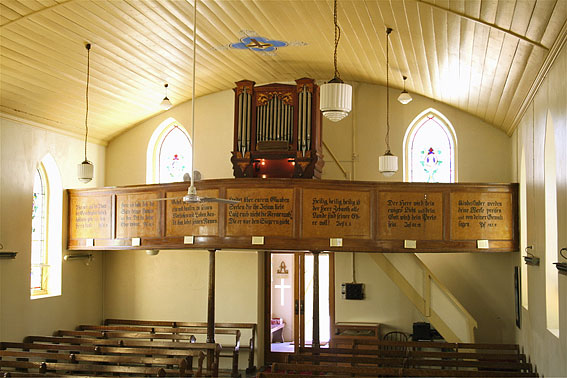
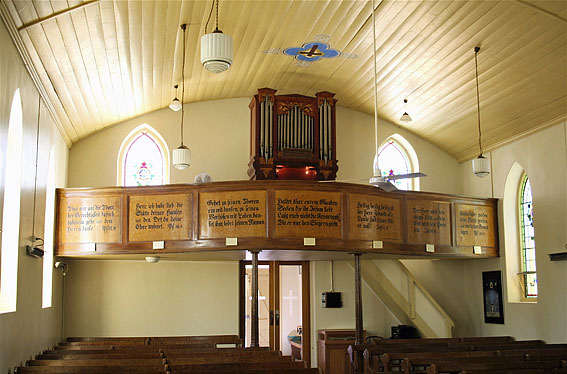
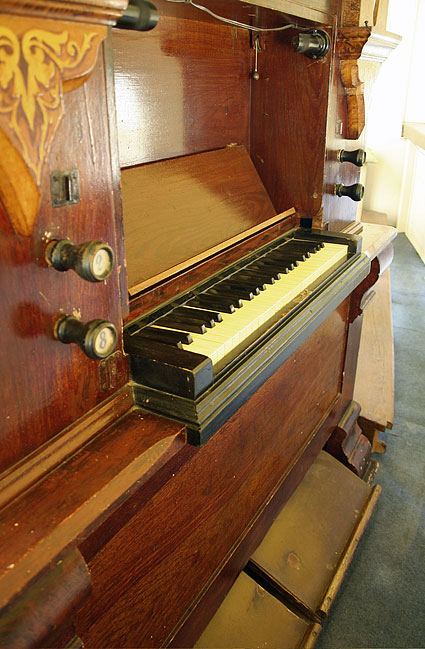
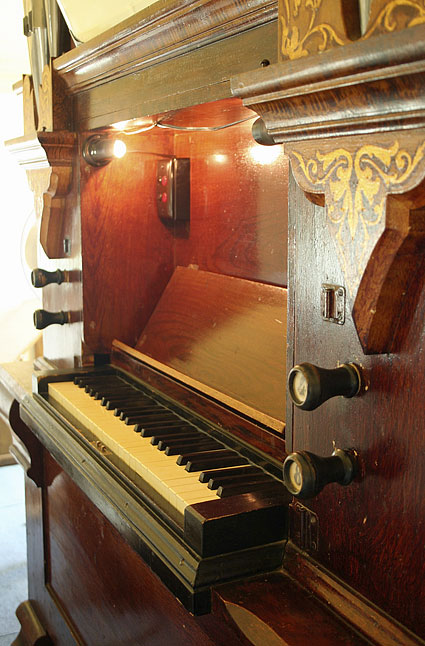
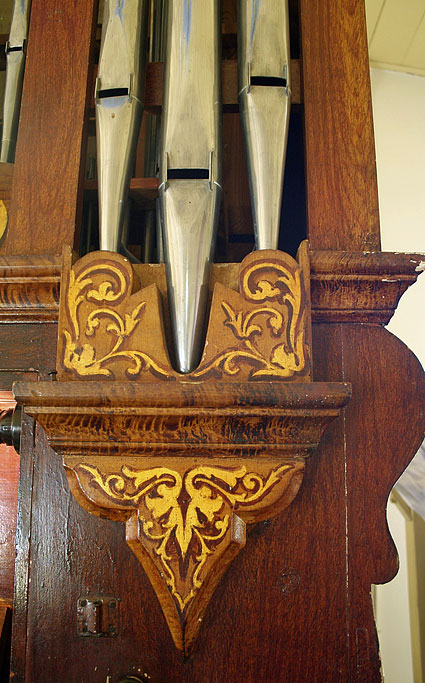
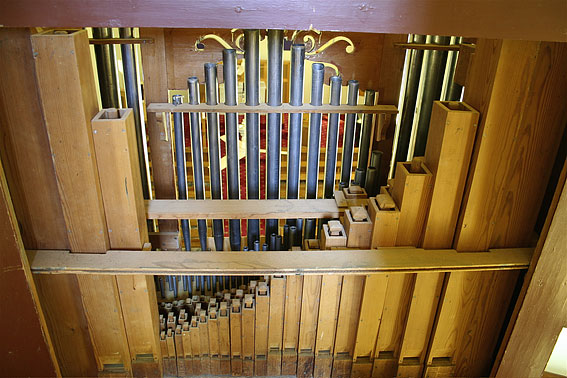
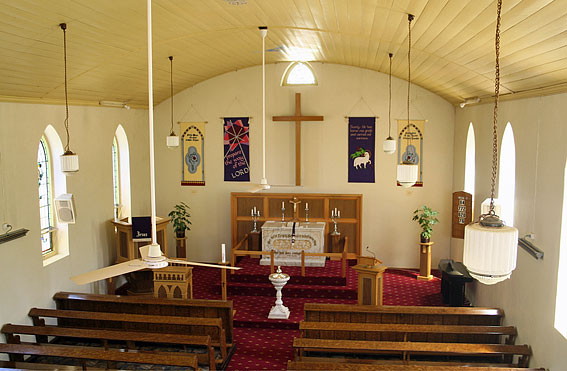
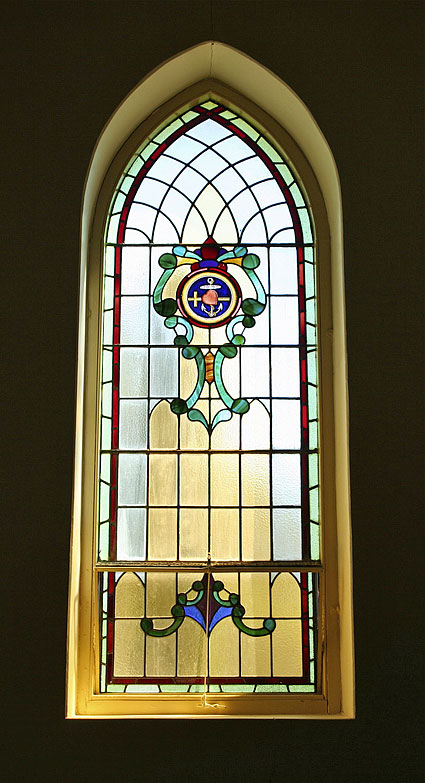
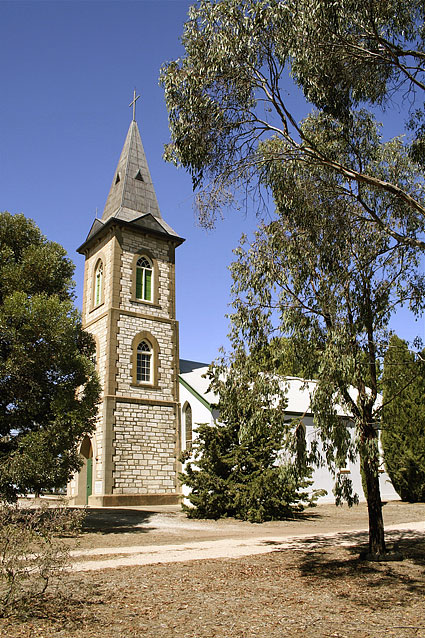
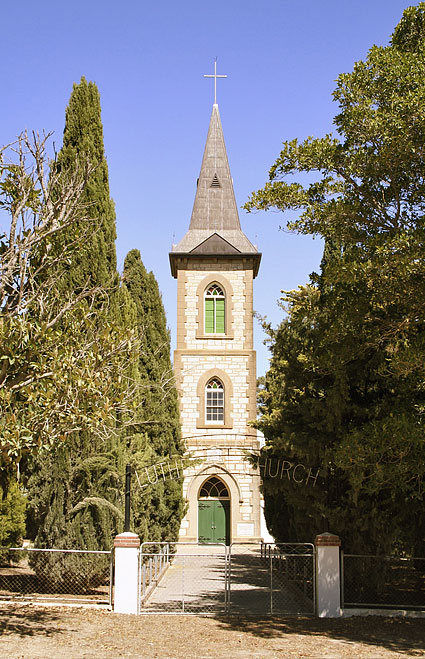
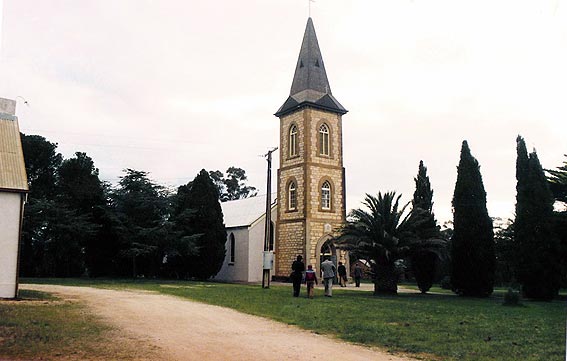
(older photo)
Photos: Trevor Bunning (March 2009)
